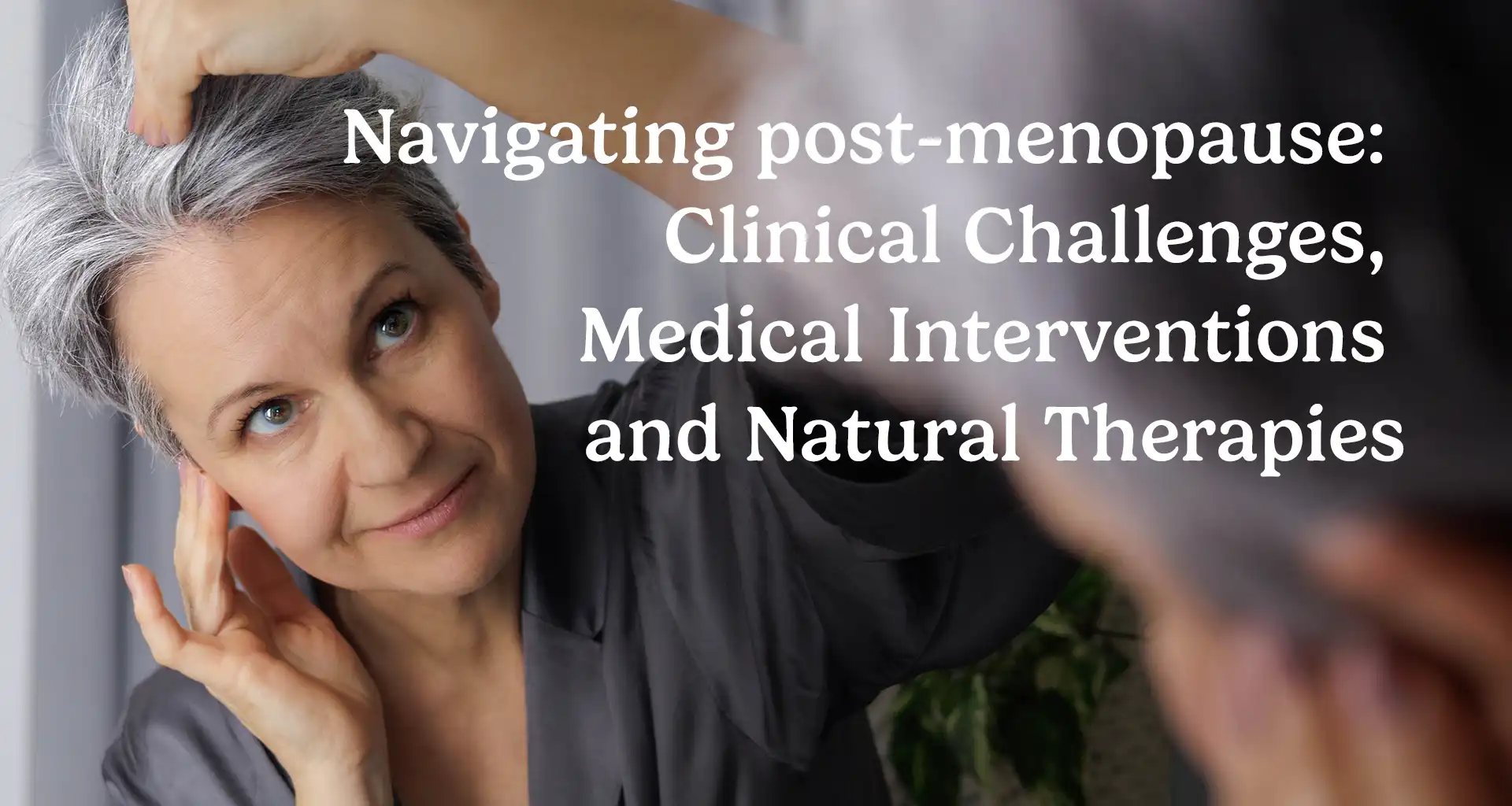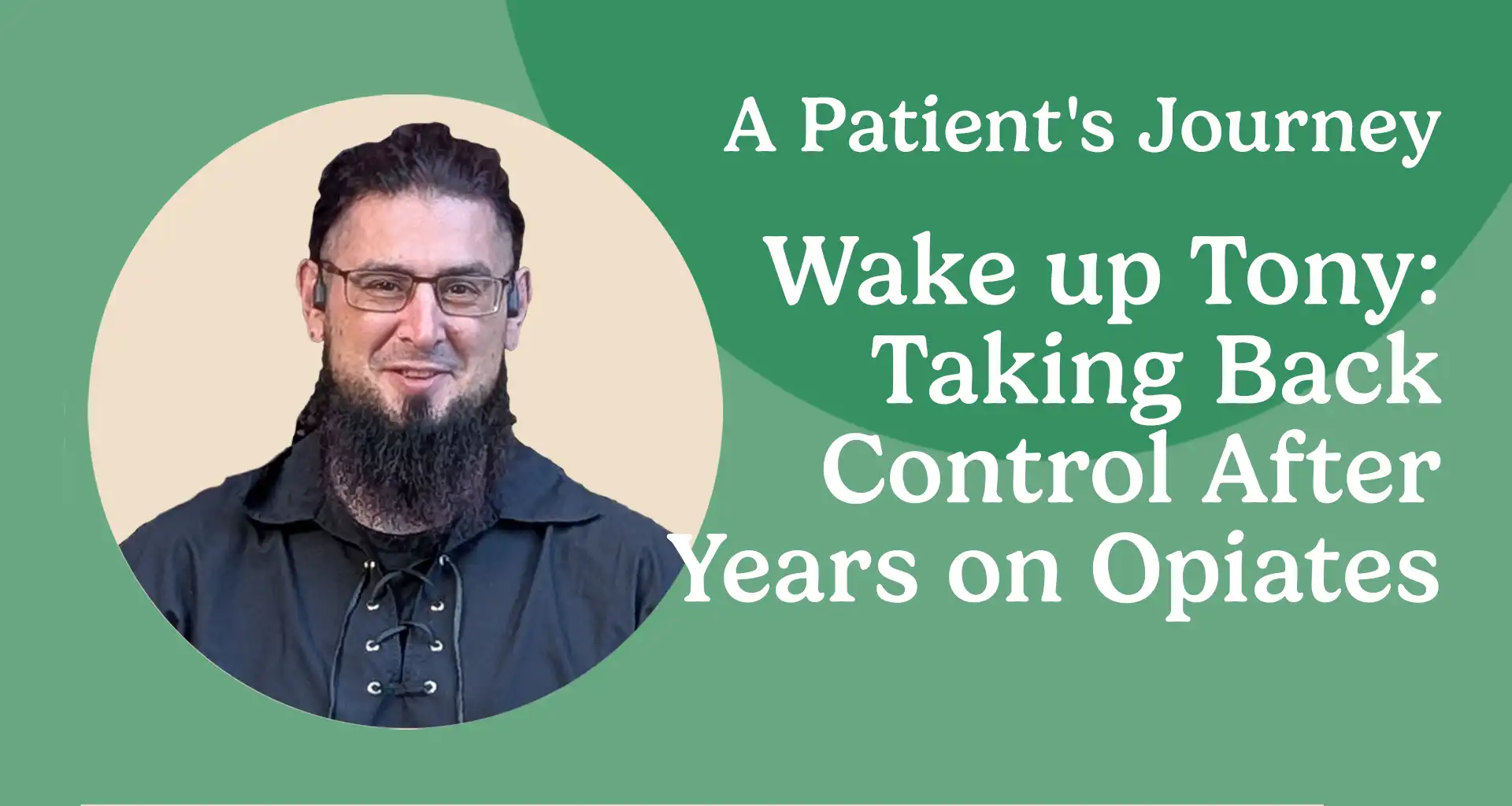
Navigating post-menopause: Clinical Challenges, Medical Interventions and Natural Therapies
“I have to admit, turning 55 felt like being handed a VIP pass to the ‘Body Changes and Emotional Turbulence Club’. One minute you’re wise and glowing, the next you’re wondering why you can no longer squat down as your knees sound like grating cheese. I don’t hate ageing. I’m just not in love with the fine print – a,k,a, the fine lines, the dry thinning hair, the mental blocks etc.
But – and it’s a big but – I am truly grateful to be me, in 2025 and not my mother or grandmother, who had to negotiate this road less travelled, incognito, invisible – no help, no words of recognition, no sympathy. Our cohort of post-menopausal women are so lucky”
Menopause – what is it?
Frequently, the word ‘menopause’ is used as the generic term, especially by the media, to include all four stages of a woman’s fertility timeline, from a girl’s menarche (when she starts ovulating and has her first periods), throughout her potential childbearing years, leading up to her mid-40s, when the pre and perimenopausal stages are reached, until the final stage of her reproductive cycle when she no longer has had any periods for a full twelve months.
Strictly speaking, it is this last, fourth stage, which is the true meaning of the word ‘menopause’ – the absolute end of all monthly menstruation, and the serious decline of reproductive hormones.
In the UK, the average age for the onset of periods is around 12, and while the average age for menopause is about 51, it can occur naturally anywhere between 45 and 60 and may vary depending on genetics, health status, and lifestyle, with individual experiences varying significantly.
If the menopause occurs prior to 45, it is considered, medically, to be premature or early menopause. Technically, your menopause is considered to have occurred when you have not had a period for a full 12 months since your last, at which point you will have a permanent cessation of ovulation and a permanent decrease in female hormone levels. It is this significant decrease in your hormones which is the main culprit for some of the many problems some women experience.
While the cessation of menstruation may bring relief from monthly symptoms, and the concern of becoming pregnant, it also signals profound hormonal changes—specifically a sharp decline in oestrogen and progesterone—that can lead to challenging physical, emotional, and clinical symptoms.
Ironically, men’s testosterone levels decline with older age, but, since it is no longer balanced by oestrogen levels, a woman’s post-menopausal testosterone level will slightly rise, bringing with it unpleasant side effects such as unwanted facial and body hair, male pattern weight gain around the abdomen, a higher risk of coronary disease, alongside some male pattern hair loss, with thinning hair at the temples.
In this article, we will explore some of the health issues which may be faced by post-menopausal women, with recommendations for specific medical blood testing, evidence-based pharmaceutical options, natural treatments and supplements, and the emerging role of medicinal cannabis, including its pharmacology, such as provided by The Lyphe Clinic.
Clinical and Physical Problems in Post Menopause
- Osteoporosis and Fracture Risk
Oestrogen plays a crucial role in maintaining bone density. Its decline can lead to increased bone resorption, reduced structural bone matrix formation, and a higher risk of osteoporosis. Postmenopausal women lose bone mass at an accelerated rate, especially in the first 5–10 years after menopause, increasing fracture risk—especially hip, spine, and wrist fractures.
- Cardiovascular / Systemic Disease
Prior to menopause, women have a lower risk of cardiovascular disease compared with men, partly due to the protective effects of oestrogen. After menopause, the risk equalises and eventually surpasses that of men. Postmenopausal women may experience:
- A rise in LDL (“bad”) cholesterol
- A fall in HDL (“good”) cholesterol
- Increased arterial stiffness and raised blood pressure
- Become insulin resistance, leading to Type 2 diabetes
- Become anaemic
- Experience excessive fatigue syndrome
- Genitourinary Syndrome of Menopause (GSM)
GSM encompasses symptoms affecting the vulva, vagina, urethra, and bladder, including:
- Vaginal dryness and atrophy
- Painful intercourse (dyspareunia)
- Recurrent urinary tract infections
- Urinary urgency and incontinence
- Lichen sclerosis (most usually lichen sclerosis) / Lichen planus (less common but occasional)
These symptoms can cause huge emotional distress, and significantly impair quality of life and intimacy.
- Weight Gain and Body Composition Changes
The decline in oestrogen shifts fat storage from the hips and thighs to the abdomen, increasing visceral fat (fat around the internal organs such as the liver, heart, kidneys, intestine), which is metabolically active and associated with higher risks of insulin resistance, type 2 diabetes, and cardiovascular disease.
- Cognitive Changes
Postmenopausal women often report:
- Memory lapses – “what was his name?” “where did I put my xxx?”
- Difficulty concentrating
- “Brain fog”
These changes may be related to hormonal shifts, sleep disturbances, stress or other metabolic factors.
- Sleep Disturbances
Hot flushes, night sweats, anxiety, and restless leg syndrome contribute to poor sleep quality, which in turn affects mood, cognition, and immune function. Sadly, these symptoms can be carried over from the peri-menopausal phase.
- Mood Disruption
Depression and anxiety can become more prevalent due to hormonal fluctuations and changes in neurotransmitter regulation. This can manifest as increased irritability, anxiety or general mood swings. Women with a prior history of depression or PMDD (Premenstrual dysphoric disorder) are at higher risk.
Recommended Medical Tests and Screenings
For postmenopausal women, early and routine testing is crucial for identifying and managing risks. Some of the main assessments and tests to ask for from your GP include:
- Bone Mineral Density Scan (DEXA)
- Purpose: Diagnoses osteoporosis (significant bone density loss, requiring medication) or osteopenia (your bone density is lower than average but not yet osteoporotic)
- Recommended: Every 2 years after age 65 or earlier if there are known risk factors
You can ask your GP to be referred for an NHS Dexa scan if you have a family history of osteoporosis, if you have been a heavy smoker, or other medical issues which may increase your risk. However, it costs only about £140 to have one done privately, and were you to be determined as at risk, any further treatment would fall back under NHS guidelines.
- Lipid Profile
- Purpose: the test evaluates your cholesterol and triglyceride levels. Menopause is often associated with a progressive increase in total cholesterol. This can impact your cardiovascular health, and monitoring is important especially if you have a family history of heart disease.
- Frequency: Every 5 years (more frequent if abnormal)
- HbA1c and Fasting Glucose
- This blood test shows what your average blood sugar levels have been over the previous few months and is a key tool for diagnosing and managing for insulin resistance (when the muscles, fat and liver cells in your body do not respond as they should to insulin, a hormone that regulates blood sugar) or type 2 diabetes / pre-diabetes.
- Blood Pressure Monitoring
- Recommended: Annually, or more frequently if you have experienced high blood pressure prior to your post menopause phase. Your GP will monitor this. If you experience occasions of light headedness, headaches, chest pain or shortness of breath do make an appointment to see your GP, since this could be hypertension (abnormally high blood pressure), which needs to be diagnosed and treated.
- Thyroid Function Tests (TSH, Free T4)
- Hypothyroidism (low thyroid function) is more common post menopause. It is estimated that at least 12% to 20% of post-menopausal women have low thyroid levels, often linked with lower oestrogen levels. Since menopause and thyroid dysfunction can share similar symptoms, such as fatigue, weight changes, mood swings and difficulty sleeping, these are the best blood tests to ask your doctor to screen for. Declining oestrogen levels both peri and post menopause can affect your thyroid function and may increase your susceptibility to, or risk of, autoimmune thyroid diseases.
- Mammography
- Frequency: Every 2–3 years after age 50 in the UK (or more frequently based on individual risk) You will receive a letter inviting you for a mammogram.at your local Breast Screening Unit.
- Cervical Screening
- Frequency: Every 3–5 years up to age 64 in the UK. For peace of mind, after the age of 64, you can pay privately for a screening test.
- Vitamin D and Calcium Levels
- This is vital to evaluate your bone health. Supplements of calcium must always be paired with vitamin D, since the vitamin D facilitates the absorption of calcium in the intestine. The best and most easily absorbed form of calcium to take is Calcium Citrate – since it can be taken with or without food and causes the least amount of stomach upset.
- Liver and Kidney Function Tests
- Especially important when initiating medications like bisphosphonates to help with very low bone density. Or before commencing HRT.
- Hormone Panels (optional)
- FSH (follicle stimulating hormone), LH (luteinising hormone), and oestradiol levels may be evaluated for a differential diagnosis, but they are not always essential, since by default, any woman in her post-menopausal phase will have altered. Oestradiol (E2) is one of the most important steroid hormones of the oestrogen group, as it plays a key role in bone health, brain function, our mood, and general reproductive health.
- Screening for Anaemia
- Anaemia is the general term used when the body has too few healthy red blood cells. Just as we recognise that a car is a car, we also know that there are several brands of cars available. Using that analogy, various types of blood tests exist which may show that you are anaemic: however, because there are several sub-types of anaemia (brands of car) which may be causing your anaemia, it is necessary to determine why you are anaemic.
- It is very important to check this, since fatigue can be a post-menopausal symptom, yet it may mask another underlying physical cause. Do ask your doctor to check, if you are feeling excessively tired and run down.
Medically Prescribed Treatments
Forms: Oral tablets, implants, transdermal patches, gels, vaginal rings or creams
Components: Oestrogen alone (for women without a uterus) or combined with progesterone (for women with a uterus)
Benefits:
- Relieves vasomotor symptoms (hot flushes, night sweats)
- Improves sleep and mood
- Reduces the tendency of bone loss / helping stabilise osteoporosis
- Reduces vaginal dryness and associated gynaecological problems
Risks:
- Slight increase in breast cancer with combined HRT
- Small risk of venous thromboembolism or stroke, especially with oral forms
- Bisphosphonates (for example Alendronate)
Used for osteoporosis, these drugs inhibit bone resorption (break down), and help strengthen the outer cortex of the bones, making the bones stronger and a fracture less likely.
- Selective oestrogen receptor modulators (SERMs)
E.g., Raloxifene—mimics oestrogen in bone but blocks it in breast and uterine tissue.
- SSRIs / SNRIs (Anti-depressants)
Low-dose antidepressants like paroxetine, venlafaxine, or fluoxetine are sometimes prescribed for hot flushes or mood symptoms in women who cannot take HRT.
- Topical Vaginal Oestrogens
For GSM, vaginal oestrogen rings, tablets, or creams provide local relief with minimal systemic absorption. They are nowadays, generally considered safe to use even for those women, who have had hormone receptor-positive breast cancer, since the oestrogen is not absorbed into the blood stream.
Natural Products and Lifestyle Interventions
- Dietary Modifications
A Mediterranean-style diet rich in vegetables, oily fish, whole grains, nuts, and olive oil supports cardiovascular and bone health. Foods high in phytoestrogens (e.g., soy, flaxseed) may help alleviate mild vasomotor symptoms.
Post menopause it is crucial that women eat sufficient good protein and do weight bearing exercises for keep fit. Greek yoghurt, some grains and pulses, leafy green vegetables such as spinach, beetroot, eggs, some dairy (m cheese and milk) , omega 3 high fish (mackerel / sardines) , white meat such as chicken and finally red meat are all good sources of protein – and are written in a cascade here of the best source to last.
Highly processed meats such as salami and biltong, whilst having a protein content are not a good choice as they are proven to be highly carcinogenic.
- Calcium and Vitamin D
- Calcium: 1000–1200 mg/day from food or supplements
- Vitamin D3: 800–1000 IU/day to support bone mineralisation
- Weight-Bearing Exercise
- Increases bone density
- Improves muscle mass and balance (fall prevention)
- Enhances mood and insulin sensitivity
- A well-paced walk four times a week for half an hour
Recommended: 150 minutes of moderate-intensity aerobic activity + strength training twice weekly
- Mind-Body Practices
- Yoga: Improves flexibility, reduces anxiety
- Tai Chi: Enhances balance and bone strength
- Meditation: Reduces stress and cortisol levels
- Black Cohosh and Red Clover
These herbal supplements are commonly used for menopausal symptoms, though evidence is mixed. Black cohosh may relieve hot flushes, but long-term safety, especially for liver function, needs caution.
- Omega-3 Fatty Acids
Support cognitive function, reduce inflammation, and may help with depressive symptoms. Smoked mackerel twice a week will be a great choice.
Medicinal Cannabis: Its Role in Postmenopausal Care
- What Is Medicinal Cannabis?
Medicinal cannabis refers to the use of cannabis-based products for therapeutic purposes. Within a Cannabis sativa plant, a wide variety of chemical compounds can be found. Of these, there is a specific group of substances known as cannabinoids, which work within our body’s own endocannabinoid system (described below). It is believed that there could be over 100 different cannabinoids in a plant, but the two most well-known and most studied are:
- THC (delta-9-tetrahydrocannabinol) – most effective in managing pain, reducing nausea and vomiting, stimulating appetite, and addressing certain mental health issues. It is both psychoactive and analgesic
- CBD (cannabidiol) – on the other hand, is non-psychoactive, works as an anxiolytic (alleviating anxiety and depression), is anti-inflammatory thereby reducing inflammation, and has neuroprotective properties, which is highly beneficial for illnesses such as epilepsy.
In the UK, medicinal cannabis can be prescribed under specialist care for specific indications, such as from the Lyphe Clinic.
- 2. Common Post Menopausal Symptoms Targeted by Medicinal Cannabis
- Chronic pain (e.g., arthritis, back pain)
- Sleep disturbances
- Mood disorders / anxiety
- Hot flushes (limited but emerging evidence)
- Bone metabolism (only preclinical data so far, scientifically)
- Pharmacology: How Cannabis Works in the Body
Within our body, each of us has an endocannabinoid system (ECS), which is a complex network of receptors, enzymes, and endogenous cannabinoids that regulate mood, pain, immune function, appetite, and temperature. Endogenous (occurring within our body naturally) cannabinoids (also called endocannabinoids) are natural chemicals made by your own body.
Key Components of the ECS:
- CB1 Receptors: Primarily found in the brain and nervous system
- CB2 Receptors: found in immune cells and peripheral tissues of the body
Mechanism of Action:
- THC partly binds to the two receptors, CB1 and CB2, thereby helping to reduce your pain perception, and induces relaxation or a feeling of well-being.
- CBD works more indirectly and is linked to mood and pain relief. It can also be anti-inflammatory and can calm the brain’s overactive immune signals, can be protective, and improve brain cell function.
Cannabis and Menopause:
- Pain: THC and CBD reduce chronic musculoskeletal and joint pain common in older women
- Sleep: CBD promotes deeper sleep cycles; THC shortens sleep onset time
- Mood: Both THC and CBD have antidepressant and anxiolytic properties through serotonin receptor interaction – a little like some anti-depressant medications.
- Bone Health: Preclinical studies suggest that CB2 activation may promote osteoblast activity and inhibit bone resorption, though human data is limited
- Dosage and Administration
Medicinal cannabis products include:
- CBD oils / tinctures / gummies / vapes
- THC-containing capsules / oils
- Topicals (for joint pain)
- Vaporizers (rapid onset but shorter effect)
Treatment should be individualised, starting with a “low and slow” approach to dosing, especially to minimise psychoactive side effects.
|
British Menopause Society Advice |
||||||||||||||||||
|
Conclusion
Post-menopause is a multifaceted life stage involving profound hormonal, physiological, and psychological shifts. Addressing these changes requires a holistic approach: vigilant screening, appropriate medical therapy, lifestyle optimisation, and—where appropriate—the incorporation of natural therapies, including for some women, prescribing of medicinal cannabis.
While hormone therapy remains the cornerstone for many symptoms, an increasing number of women are seeking holistic, integrative solutions that align with their values and preferences. With proper clinical guidance, post-menopausal women can not only manage their symptoms but also optimise their long-term health, independence, and vitality.
Historically, this natural and inevitable transitional phase of a woman’s life was often negatively portrayed. Nowadays, however, with its decreasing stigma, and increasing awareness of helpful aids and strategies to overcome symptoms, it can become a woman’s most productive and exciting life stage, and one to be celebrated and enjoyed.
The Lyphe Clinic can provide you with accurate and up to date advice regarding medicinal cannabis prescription to aid with certain post-menopausal symptoms.
Disclaimer: Always consult with a qualified healthcare provider before starting any new medical treatment, including natural supplements or cannabis-based medicines.
If you enjoyed this article, and would like to find out more about women’s health, you can read the following articles:
Medical Cannabis for Women’s Health
Natural Perimenopause Treatments Managing Symptoms Without HRT

Book an online appointment
Lyphe is your patient-first path to wellness, so book an appointment with one of our medical cannabis expert Doctors and get the relief you need.
Related Insights
Whilst you’re here you might also like to read…


